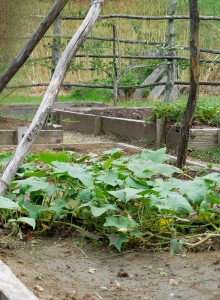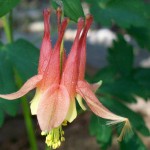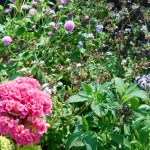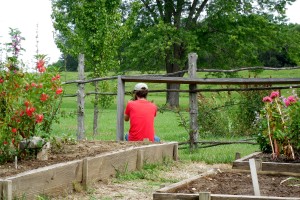4 septembre 2014 jeudi (Thursday)
93 F, Cloudy
3 mph SE wind
The FdC Jardin Potager Heirloom Saturday will be held this weekend, September 6, regardless of a chance of showers Saturday morning. Make your way to the fort’s store building across from the garden beginning at 10 AM and seed samples of flower and fall vegetables with accompanying information will be shared. Late summer and early fall is a perfect time to relocate seedlings discovered while replanting the jardin for the fall season. There are a limited number borage, calendula, rue, and wormwood seedlings looking for a good home. Later in the morning, with the cooperation of the weather, we can walk in the garden where you may gather some of our jardin seeds of your own.
The descriptions of early New France and Illinois country French colonial gardens leave such a strong vision of beauty mixed with utilitarian need. As noted by many observers ranging from the late eighteenth and early nineteenth century through modern historians, l’habitant garden reflected comfort, pleasure, and aesthetic qualities to a greater extent than those of the British or American colonists. According to Swedish botanist, Pehr Kalm, whose mid eighteenth century travels through North America remarked on the tradition of the kitchen garden in French communities and opined that style of household gardening was brought to the Mississippi Valley from French Canada, where it was common to find kitchen gardens from Quebec to Montreal. In 1793, a young lad from Philadelphia, Henry Brackenridge, much admired the kitchen garden of the Vital St. Gemme Bauvais residence in Saint Geneviève, located in that French community across the Mississippi on its western shore:
“The garden-in which the greatest variety and the finest vegetables were cultivated, intermingled with flowers and shrubs: on one side of it there was a small orchard containing the choicest fruits. The substantial and permanent character of these inclosures is in singular contrast with the slight and temporary fences and palings of the Americans.”
These accounts help create our jardin potager layout and give us insight to the creative and talented horticultural skills of the early French colonists. While we may never know the exact varieties of plants grown in their jardins, through research into the popular and general plants of the era, our garden offers heirlooms common throughout Europe and America in the eighteenth century. Furthermore, in the fifth year of our jardin potager project, the varieties that have excelled in our climate and conditions in the Illinois country have revealed some hardy and reliable choices for a heritage garden. This Saturday we will focus on the successful heirloom flower standouts appropriate to the eighteenth century. They include; ageratum, balsam, bee balm, borage, calendula, columbine, globe amaranth, love in the mist, French or common mallow, nasturtium, heliotrope, rose mallow, fringed pinks, and field poppies. These flowers while providing beauty also often had culinary/medicinal/herbal qualities as well.
The weather this weekend should be rain cooled and a perfect time to reflect a moment on the heirlooms of the past. It is hoped that you may visit our jardin and share in a little garden history.




Leave a Reply